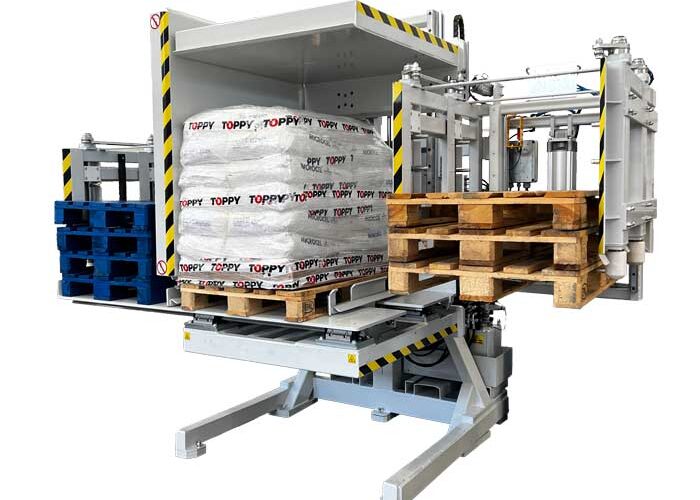Pallet inverters or pallet tippers or pallet pushers are established methods used to change pallets.
- Pallet pushers push the pallet secured at the bottom, side, and back of the machinery. It tightly holds unit loads and pushes them from the original to target pallets.
- Pallet inverters allow you to turn the complete unit load upside down. It needs items to get evenly packed or clamping down can be hard.
- Pallet changers apply pressure on goods sideways via clamping and lifting from the original pallet.
- Pallet turners turn the pallet with loads on one corner and release the pallet. The empty pallet is manually removed and a new pallet is inserted back.
Pallet exchangers are useful in simple machine manufacturing, warehouse, and logistics industries used to load or unload pallets holding bulk merchandise or boxes, cartons, or containers. The food, automotive, retail, and manufacturing sector prepares product or item delivery on a pallet.
Pallets are susceptible to getting severely damaged and need replacement. In several facilities, shipping pallets need to be switched for compliance or to fulfill sanitization protocols.
Top Industries are leading manufacturers of different pallet inverter models designed to increase efficiency, productivity, and safety. Material flow optimization offers unbeatable savings because of an increase in process efficiency. Contaminated and defective unit loads can be exchanged too quickly than manual handling. It not just increases goods flow but also enhances ergonomics for your employees.
Safety tips to handle the easy-to-use material handling equipment
The pallet exchangers are of different types inverters, sliders, pushers, changers, tilters, and turners. The working is simple and any non-tech employee can handle the operation but at the same time, it is also deceptive because some operators may ignore or forget safety protocols when they work around it.
Under every circumstance, heavy unit loads need handling with caution. So, organizations need to follow the given safety tips to avoid accidents and lessen their effects.
- Allocate pallet exchanger operations to trained and certified employees. Lack of training can make the employee handle the handling device unsafely.
- Operators need to wear proper PPE. Remember, the operators adhere to it without any exception or excuse. There are chances that a loaded box or container will slip from a stacked pallet.
- Pallet exchangers have a movement extent that can be determined. So, create a clearance area and enforce a rule that no one will stand within the clearance zone when the machinery is operated. Choose a high-traffic grade pain and visible signs to delimit the clearance perimeter.
- Accidents are inevitable if you ignore the pallet exchanger’s maintenance. Periodic maintenance is a must. The operators need to check before using. In case they find bolts and nuts loose or any other sign indicating issues report it to the manager and not use it until you are told it is safe.
- Every employee working in the facility has to be made aware of their responsibilities on how to maintain safety during work. Discuss Occupational Health & Safety protocols often because a refresh course is legally mandatory and even helps in efficiency. The team’s morale improves and coworkers trust one another working around the equipment.
Top Industries is devoted to helping its customers maximize pallet exchanger models purchase. They help with instruction, training, and demonstration. You can watch their YouTube videos for more details!

